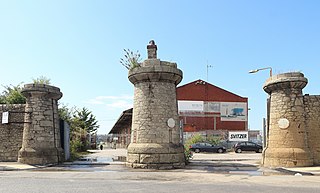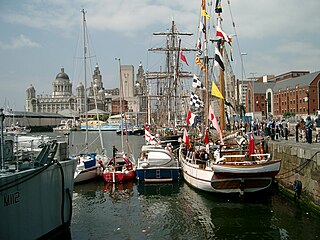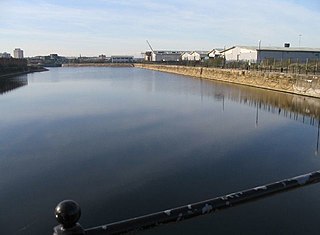
Birkenhead is a town in the Metropolitan Borough of Wirral, Merseyside, England; historically, until 1974, in Cheshire. It is on the Wirral Peninsula, along the south bank of the River Mersey, opposite the city of Liverpool. At the 2011 census, it had a population of 88,818.

Alexandra Dock is a dock on the River Mersey, England, and part of the Port of Liverpool. It is situated in the northern dock system in Bootle. Alexandra Dock consists of a main basin nearest the river wall and three branch docks to the east, with the southern branch mostly filled in.

Langton Dock is a dock on the River Mersey, England, and part of the Port of Liverpool. It is situated in the northern dock system in Bootle, connected to Alexandra Dock to the north and Brocklebank Dock to the south. Langton Dock locks provide a working connection to the river; one of the two remaining operational river entrances in the northern dock system.

Bramley-Moore Dock is a fully used dock on the River Mersey in Liverpool, England, and part of the Port of Liverpool. The dock is located in the northern dock system in Liverpool's Vauxhall area, and is connected to Sandon Half Tide Dock to the north and Nelson Dock to the south. Jesse Hartley was the architect, and the dock opened in 1848.

Nelson Dock is a dock on the River Mersey, England, and part of the Port of Liverpool. It is situated in the northern dock system in Vauxhall, connected to Bramley-Moore Dock to the north and Salisbury Dock to the south.

Salisbury Dock is a dock on the River Mersey, England, and part of the Port of Liverpool. It is situated in the northern dock system in Vauxhall and is connected to Nelson Dock to the north, Trafalgar Dock to the south and inland to Collingwood Dock.

Collingwood Dock is a dock on the River Mersey, in England, and part of the Port of Liverpool. It is situated in the northern dock system in Vauxhall, and is connected to Stanley Dock to the east and Salisbury Dock to the west.

Victoria Dock was a dock on the River Mersey, England, and part of the Port of Liverpool. Situated in the northern dock system, it was connected to Trafalgar Dock to the north and West Waterloo Dock to the south.

Waterloo Dock is a dock on the River Mersey, England, and part of the Port of Liverpool. It is situated in the northern dock system in Vauxhall and connected to Princes Half Tide Dock to the south. The site of Victoria Dock is located to the north.

Prince's Dock is a dock on the River Mersey, England, and part of the Port of Liverpool. It is the most southerly of the docks situated in the northern part of the Liverpool dock system, connected to Prince's Half-Tide Dock to the north. The dock is now in the buffer zone to one of Liverpool's World Heritage Sites.

Canning Dock on the River Mersey is part of the Port of Liverpool in Northern England. The dock is in the southern dock system, connected to Salthouse Dock to the south and with access to the river via the Canning Half Tide Dock to the west. The Canning Graving Docks are accessed from the dock.

Salthouse Dock is a dock on the River Mersey, England, and part of the Port of Liverpool. It is situated in the southern dock system, connected to Canning Dock to the north, Wapping Dock via Wapping Basin to the south and Albert Dock to the west.

Coburg Dock is a dock on the River Mersey, in England, and part of the Port of Liverpool. It is situated in the southern dock system, connected to Queens Dock to the north, Brunswick Dock to the south.

Brunswick Dock is a dock on the River Mersey, in England, and part of the Port of Liverpool. It is situated in the southern dock system, connected to Coburg Dock to the north, Toxteth Dock to the south.

The Great Float is a body of water on the Wirral Peninsula, England, formed from the natural tidal inlet, the Wallasey Pool. It is split into two large docks, East Float and West Float, both part of the Birkenhead Docks complex. The docks run approximately 2 miles (3 km) inland from the River Mersey, dividing the towns of Birkenhead and Wallasey. The Great Float consists of 110 acres of water and more than 4 miles (6 km) of quays.

Egerton Dock is a dock at Birkenhead, in England. The dock is situated between East Float and Morpeth Dock, within Birkenhead's dock system.

Morpeth Dock is a dock at Birkenhead, Wirral Peninsula, England. The dock is situated between the River Mersey and Egerton Dock.

Bidston Dock was a dock at Birkenhead, in England. It was situated to the west of the Great Float, between Bidston and Poulton.

The Wallasey Dock, was a dock at Birkenhead, Wirral Peninsula, England. The dock was accessed via East Float to the west, until Wallasey Dock was filled at the turn of the millennium.

The Wirral Street Car is a proposed tramway from Bidston Dock to Woodside Ferry Terminal to provide transport links for the Wirral Waters development. The line will use pre-existing rolling stock as well as incorporating both the disused Birkenhead Dock Branch and the Wirral Tramway that already operates as a heritage service from the Wirral Transport Museum to Woodside Ferry Terminal.























